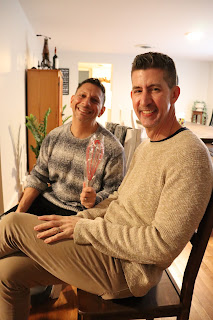Smudge ran away on New Year’s Eve 2004. She wasn’t much of a housecat, to be honest. She’d been given to us by a friend and we only had her for three months, the first six weeks of which she spent hiding in our basement and the next six weeks skulking around avoiding us. She got out on a grey, rainy day with the temperature just above freezing and we figured she wouldn’t be gone long but she never came back and eventually we stopped looking.
Maybe five weeks later we went to the Humane Society to get another cat. We wanted a friendly one and there was a grey cat – a “blue mackerel tabby” if you want the correct cat-show term – who played with us in the little room where you can go before making any decisions so we took her home. Her name at the pound was Smokey but when five-year-old Oliver started referring to her as Smokes we figured we needed a new name. I wanted Mithrandir – “grey wanderer,” as any Tolkien nerd can tell you – and Kim agreed if we shortened it down to Mithra. We often called her Pookie for some reason. We collectively decided her birthday was Labor Day 2004 since that seemed to be about the right age for her when we got her.
She was a good cat for a family. She was patient with small children and generally friendly to everyone else. She’d play all sorts of games. I still laugh at the Paper Bag Incident. Somewhere we have a video of her careening down the sliding board of the old swing set we had in the back yard when the kids were little. She did her part to control the wild rabbit population in the neighborhood, much to the annoyance of some nitwit who left us an anonymous note about it. We gave her more treats for it. She put up with 4H Cat Shows, vet visits, and – grudgingly – Midgie. She had an extra-long tail that she could lay between her ears when she was younger. It would dangle between her eyes as if she were some deep-sea fish.
She’s been fading bit by bit for a while now, which you’d expect in a 19-year-old cat. She’s been blind for over a year and our living room became a Geriatric Cat Facility, with a set of stairs up to the sofa where her pet-warmer electric pad was, and a big mat where we could feed her the kitty snacks and wet food we thought would help her gain some wieight even as she slowly got thinner anyway.
When we got back from Tennessee we could see she’d declined pretty steeply despite being well cared for while we were away. That happens with old cats. She couldn’t really stand anymore, and her fur was looking disheveled. We set her up in the downstairs bathroom and tried to keep her hydrated but when you put together a cat hospice there is only one way that ends.
This morning it was clear that things had run their course, and eventually we found a veterinarian who was open on the Saturday before New Year’s. All four of us went with her, and all four of us brought her home to rest.
She’s buried in the back, in the little pet cemetery that we’ve slowly created in the nearly three decades since we moved into this house, among the rabbits and turkey chicks. We all took turns and sent her off into her next adventure.
Fare thee well, Mithra. You were a good cat, and well loved.
Maybe five weeks later we went to the Humane Society to get another cat. We wanted a friendly one and there was a grey cat – a “blue mackerel tabby” if you want the correct cat-show term – who played with us in the little room where you can go before making any decisions so we took her home. Her name at the pound was Smokey but when five-year-old Oliver started referring to her as Smokes we figured we needed a new name. I wanted Mithrandir – “grey wanderer,” as any Tolkien nerd can tell you – and Kim agreed if we shortened it down to Mithra. We often called her Pookie for some reason. We collectively decided her birthday was Labor Day 2004 since that seemed to be about the right age for her when we got her.
She was a good cat for a family. She was patient with small children and generally friendly to everyone else. She’d play all sorts of games. I still laugh at the Paper Bag Incident. Somewhere we have a video of her careening down the sliding board of the old swing set we had in the back yard when the kids were little. She did her part to control the wild rabbit population in the neighborhood, much to the annoyance of some nitwit who left us an anonymous note about it. We gave her more treats for it. She put up with 4H Cat Shows, vet visits, and – grudgingly – Midgie. She had an extra-long tail that she could lay between her ears when she was younger. It would dangle between her eyes as if she were some deep-sea fish.
She’s been fading bit by bit for a while now, which you’d expect in a 19-year-old cat. She’s been blind for over a year and our living room became a Geriatric Cat Facility, with a set of stairs up to the sofa where her pet-warmer electric pad was, and a big mat where we could feed her the kitty snacks and wet food we thought would help her gain some wieight even as she slowly got thinner anyway.
When we got back from Tennessee we could see she’d declined pretty steeply despite being well cared for while we were away. That happens with old cats. She couldn’t really stand anymore, and her fur was looking disheveled. We set her up in the downstairs bathroom and tried to keep her hydrated but when you put together a cat hospice there is only one way that ends.
This morning it was clear that things had run their course, and eventually we found a veterinarian who was open on the Saturday before New Year’s. All four of us went with her, and all four of us brought her home to rest.
She’s buried in the back, in the little pet cemetery that we’ve slowly created in the nearly three decades since we moved into this house, among the rabbits and turkey chicks. We all took turns and sent her off into her next adventure.
Fare thee well, Mithra. You were a good cat, and well loved.























































